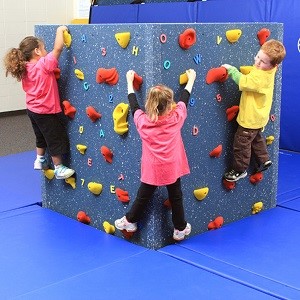Rock Climbing in Occupational Therapy
06/02/2024

In recent years there has been a trend to use climbing in occupational therapy of all ages. Almost all modern occupational therapy centers have a climbing wall where young and old spend some time climbing. The reason is that climbing requires good concentration of the mind and involves exercises that improve mobility and muscle coordination. Specialist occupational therapists can design climbing programs to suit each individual's specific needs and abilities. This may include adjusting the difficulty level of the routes, using special equipment and providing support and guidance.
The benefits of climbing in occupational therapy
Climbing is an activity that can be an effective form of occupational therapy for people of all ages and abilities. It offers a number of benefits, including enhancing strength, balance and coordination, improving self-esteem and mental health, and promoting social interaction

Enhancement of strength and endurance
Rock climbing is an excellent exercise for building muscle strength and endurance. It requires the use of many different muscle groups, including the muscles of the arms, legs, back and core. Climbing can help increase muscle mass and strength, as well as improve endurance for everyday activities.
Improve balance and coordination
Climbing requires good balance and coordination. Climbers must be able to maintain their balance on unstable surfaces and coordinate their movements to navigate rocks or mountain slopes. Climbing can help improve balance and coordination, which are important skills for everyday life.

Increasing self-esteem and mental health
Climbing can help increase self-esteem and mental health. Achieving a climbing goal can provide a sense of satisfaction and accomplishment. Climbing can also be a fun and exciting activity that can help reduce stress and depression.
Promote social interaction
Climbing can be a social activity that can help form new relationships and maintain old ones. Climbers often work together to complete a route and can support each other during challenges.

Applications in occupational therapy
Climbing can be used in occupational therapy to improve the functional capacity of people with a variety of conditions, including:
Nervous system disorders such as cerebral palsy, stroke and dementia can benefit from climbing, which can help strengthen muscles, improve balance and coordination, and reduce stress.
Musculoskeletal disorders such as osteoarthritis and injuries can benefit from climbing, which can help strengthen muscles, improve flexibility and reduce pain.
Mental health disorders such as depression and anxiety can benefit from climbing, which can help increase self-esteem, reduce stress and promote social interaction.

Conclusions
Rock climbing is a safe and effective form of exercise that can provide a number of benefits to people of all ages and abilities. Its use in occupational therapy can have significant results in improving the functional capacity of people with various conditions.
Sources
Recent posts
-
24/05/2024Backpack Guide Part Α’ 10 – 30 L
-
20/03/2024Guide for crampons
-
19/02/2024Hangboarding for beginners
-
06/02/2024Rock Climbing in Occupational Therapy
-
23/11/2023Climbing Grades
-
22/11/2023Climbing in psychotherapy
-
16/11/2023What is Bouldering
-
15/11/2023Trad VS Sport Climbing
-
15/11/2023Winter Tents
-
07/11/20233 Season Tents
-
03/11/2023Summer Tents
-
02/11/2023Lifespan Of Your Climbing Gear – Part B Metal Components
-
02/11/2023Lifespan Of Your Climbing Gear – Part A (Harness, Rope, Slings and Webbing)
-
30/10/2023Nail Vernis Aquaglutene - Vade Retro
-
30/10/2023THE LOG BOOK
-
30/10/2023Mountain cookware
-
30/10/2023Our Blog
-
30/10/2023Climbing Shoes - Quick Buying Guide
-
30/10/2023Washing and maintenance of the sleeping bag
-
30/10/2023Superlight Tents
-
30/10/2023ΙNFORMATION FOR CRAMPONS
-
30/10/2023Ice axe
-
30/10/2023INFLATABLE MATTRESS SLEEP
-
30/10/2023Nikwax secrets of waterproofing
-
30/10/2023What Is “Softshell”?
-
30/10/2023Slacklining, ένας εναλλακτικός τρόπος γυμναστικής.
-
30/10/2023Mountaineering - Hiking Boots
-
30/10/2023Waterproof Membranes
-
30/10/2023Sleeping Bags
-
30/10/2023Sleeping Mats
-
30/10/2023Base Layers
-
30/10/2023Climbing Helmets















































































































































































